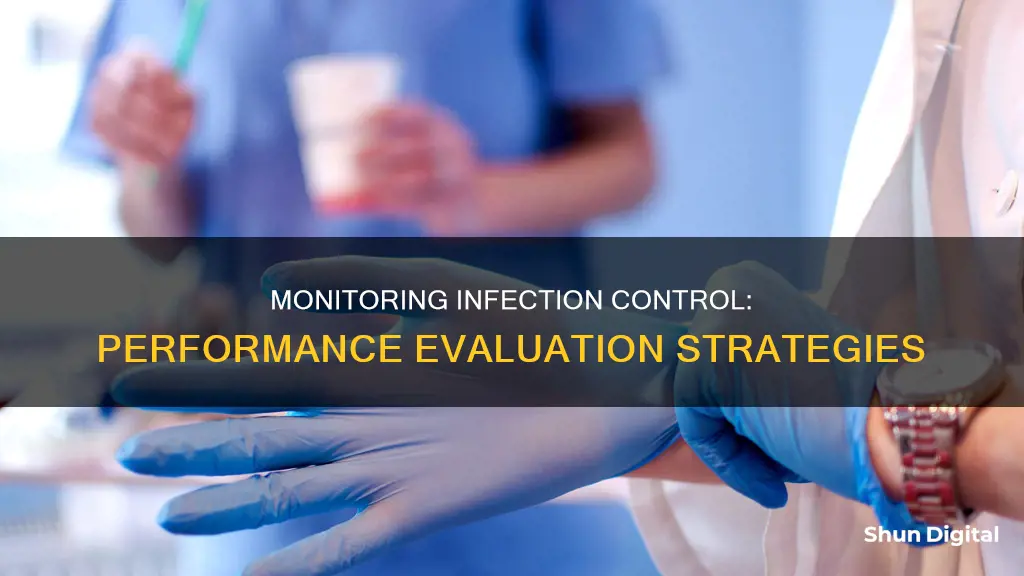
Monitoring infection control performance is a critical aspect of ensuring patient safety and preventing the spread of healthcare-associated infections (HAIs). Infection control practices aim to minimise the dissemination of infections in healthcare settings, and effective monitoring is key to achieving this goal. This involves evaluating adherence to infection prevention measures, such as hand hygiene, environmental cleaning, and the proper use of personal protective equipment (PPE). Monitoring can be challenging, especially in large facilities with a high number of employees and patients. However, continuous monitoring with feedback has proven to be an effective strategy for improving compliance with infection control practices. The COVID-19 pandemic, for instance, highlighted the importance of rigorous adherence to infection prevention and control (IPC) guidelines in hospitals, with a particular focus on hand and respiratory hygiene, proper PPE usage, and effective management of medical waste.
| Characteristics | Values |
|---|---|
| Hand hygiene | Alcohol-based hand rub or hand washing with soap and water |
| Environmental cleaning and disinfection | Routine and targeted cleaning of surfaces, with EPA-registered disinfectants |
| Injection and medication safety | Use of designated clean areas, aseptic technique, and correct disposal of needles and syringes |
| Risk assessment and personal protective equipment (PPE) | PPE selection and use based on patient interaction and potential exposure to blood, body fluids, and infectious material |
| Minimizing potential exposures | Respiratory hygiene, cough etiquette, and early detection and management of potentially infectious persons |
| Reprocessing of reusable medical equipment | Cleaning and disinfection of equipment before use on another patient, following manufacturer instructions |
| Transmission-based precautions | Additional precautions for patients with documented or suspected infectious diagnoses |
| Temporary invasive medical devices | Regular assessment of medical necessity and adherence to recommended insertion and maintenance practices |
| Occupational health | Immunizations, sick leave policies, and reporting systems for healthcare personnel illnesses |
What You'll Learn

Hand hygiene monitoring
Hand hygiene is the most significant precaution to prevent infection transmission. This can be achieved by washing hands with soap and warm water and/or by hand-rubbing with alcohol or non-alcohol-based hand sanitiser. Gloves can also be used as a standard precaution, but new gloves must be used for each patient and disposed of after each interaction.
There are a variety of methods and technologies available to monitor hand hygiene compliance. Direct observation is one method, but it is time-consuming, expensive, and typically only accounts for a small percentage of hand hygiene events.
Electronic hand hygiene monitoring systems offer a more efficient and accurate alternative. These systems use badges, worn by healthcare workers, to detect and record hand hygiene events. The badges can confirm the application of hand sanitiser and can be programmed to require a sink wash, which is verified through active engagement at the basin. Data collected by these systems can be used to monitor compliance, identify areas for improvement, and implement corrective actions.
For example, the BioVigil badge system has helped hospitals reduce cross-contamination by up to 80% and increase hand hygiene compliance to 97%. Similarly, the Ecolab Hand Hygiene Compliance Monitoring System helps hospitals improve factors that drive approximately 22% of a hospital's total Leapfrog Hospital Safety Grade.
CenTrak's Clinical-Grade Locating technology is another electronic hand hygiene monitoring solution. It uses lightweight staff badges that do not require line-of-sight to accurately record hand hygiene compliance. Their system can also be used to support contact tracing, staff duress, and nurse call automation.
By utilising these electronic monitoring systems, healthcare facilities can improve infection control, increase hand hygiene compliance, and ultimately enhance patient safety.
Best Places to Buy Affordable Monitors
You may want to see also

Infection control training for healthcare workers
Infection control training is essential for all healthcare workers to ensure safe and high-quality patient care. Training programs should be tailored to the specific roles and settings of healthcare workers, including nurses, physicians, dentists, and support staff. Here are some key components and considerations for effective infection control training for healthcare workers:
Core Infection Prevention Practices:
Healthcare workers should receive comprehensive education on core infection prevention practices, including hand hygiene, environmental cleaning, injection and medication safety, risk assessment, and the appropriate use of personal protective equipment (PPE). Training should be job-specific and provided before individuals are allowed to perform their duties, with regular refresher courses and updates on new equipment or procedures.
Standard and Transmission-Based Precautions:
Healthcare workers need to understand the difference between standard precautions and transmission-based precautions. Standard precautions apply to all patient care and include hand hygiene, environmental cleaning, injection safety, risk assessment, and PPE usage. Transmission-based precautions are additional measures taken for patients with suspected or confirmed infectious diagnoses, such as isolation and contact, droplet, or airborne precautions.
Role-Specific Training:
Training content and format should be tailored to the specific roles and settings of healthcare workers. For example, dental professionals may require more training on environmental cleaning due to their specific work setting and instruments, while nursing assistants may prioritize training on source control due to their frequent interactions with multiple patients.
Interactive and Digital Training Modalities:
Healthcare workers often prefer self-paced, digital training modalities, such as prerecorded online modules and live webinars. Interactive and digital formats can enhance knowledge retention and improve outcomes. Modular curricula that can be adapted to different formats and time lengths may be particularly effective in accommodating diverse preferences and schedules.
Compliance Monitoring and Feedback:
Monitoring compliance with infection control practices is crucial. This can be achieved through random observations, weekly rounds, and feedback collection from healthcare workers and patients. Monitoring data should be compiled into regular reports to identify areas for improvement and provide focused education.
Continuous Education and Updates:
Infection control practices evolve, and new challenges, such as emerging infectious diseases or antimicrobial resistance, arise over time. Therefore, healthcare workers should receive continuous education and updates to stay abreast of the latest guidelines, technologies, and evidence-based practices in infection control.
In conclusion, effective infection control training for healthcare workers should be comprehensive, role-specific, interactive, and continuously updated. By providing tailored training and promoting a culture of compliance and continuous learning, healthcare facilities can improve patient safety, reduce infection rates, and enhance overall healthcare outcomes.
Trump's Ankle Monitor: Fact or Fiction?
You may want to see also

Patient screening
Standard Precautions:
Risk Assessment and PPE:
Risk assessment is crucial for determining the appropriate use of PPE. PPE serves as a secondary barrier to infection transmission and includes gloves, gowns, face masks, respirators, goggles, and face shields. The selection and use of PPE should be based on the nature of patient interaction and the potential for exposure to blood, body fluids, and infectious materials.
Active Surveillance Cultures (ASCs):
ASCs are a control measure to reduce the prevalence of healthcare-associated infections. However, their effectiveness has been questioned. Intensive interventions, including isolation, can significantly reduce the incidence of infections such as methicillin-resistant Staphylococcus aureus (MRSA). Monitoring of interventions is crucial, and surveillance data should be presented and reviewed regularly.
Isolation Precautions:
Isolation of patients with suspected or confirmed infections is essential to prevent the transmission of infections. Contact isolation and pre-emptive isolation of high-risk patients are strategies used to minimize the spread of infections. Isolation should be implemented based on clinical presentation and likely infection diagnoses as soon as patients enter the healthcare facility.
Screening Strategies:
Facilities should determine screening strategies based on local epidemiology, patient risk factors, facility characteristics, and the intended purpose of screening. Broad screening approaches, such as point prevalence surveys, are preferred over targeted approaches to ensure that no colonized patients are missed. Skin swabs, particularly from the axilla and groin, are commonly used for screening.
Patient Education:
Educating patients, family members, and caregivers about infection prevention is vital. Providing information on how infections spread, how they can be prevented, and recognizing signs or symptoms that require medical attention empowers patients to play an active role in infection control. Instructional materials should be tailored to different education levels, language comprehension, and cultural diversity.
Focus on High-Risk Patients:
Particular attention should be given to screening high-risk patients, such as those with epidemiologic links to infected individuals, those with indwelling medical devices, patients receiving complex medical care, and those with frequent or prolonged healthcare stays. Additionally, patients with risk factors for acquiring specific infections, such as Candida auris (C. auris), should be prioritized for screening.
LCD Monitor Lifespan: How Long Can You Expect?
You may want to see also

Management of medical waste
Medical waste is a subset of waste generated at healthcare facilities, such as hospitals, clinics, nursing homes, laboratories, pharmacies, and more. It includes waste that may be contaminated by blood, body fluids, or other potentially infectious materials. The management of medical waste is crucial to protect the health and safety of healthcare workers, environmental health staff, waste transporters, and the general public. Improper management can lead to the spread of dangerous diseases. Here are some key aspects of managing medical waste:
Regulations and Responsibilities
In the United States, medical waste is primarily regulated by state environmental and health departments. The Centers for Disease Control (CDC), Occupational Safety and Health Administration (OSHA), and other federal agencies also have relevant regulations. The Florida Department of Health (DOH) and the Florida Department of Environmental Protection (DEP) have specific responsibilities. DOH oversees facilities that generate, transport, store, or treat biomedical waste, while DEP is responsible for biomedical waste incineration and final disposal.
Permits and Training
Medical waste generators, such as healthcare facilities, may need to obtain permits and comply with specific regulations. In Florida, for example, facilities must apply for a biomedical waste generator permit and ensure proper training for personnel handling biomedical waste. The training covers procedures, compliance with laws, and safe handling practices.
Waste Transportation and Treatment
Many facilities use registered biomedical waste transporters to remove medical waste. Treatment technologies aim to render the waste non-infectious before disposal. Alternative treatment methods include thermal treatment, steam sterilization, electropyrolysis, and chemical-mechanical systems.
Sharps and Needle Disposal
Improper disposal of needles and other sharps can pose health risks to the public and waste workers. Safe disposal methods are essential to prevent needle stick injuries and potential infections. Many states have regulations and guidelines for sharps disposal, and some offer needle collection sites to assist residents.
Infection Control Practices
Adherence to infection prevention practices is vital in all healthcare settings. This includes standard precautions such as hand hygiene, environmental cleaning, injection safety, and the proper use of personal protective equipment (PPE). Healthcare facilities should provide education and training to ensure compliance with these practices.
By following regulations, obtaining necessary permits, providing training, and adhering to infection control practices, healthcare facilities can effectively manage medical waste, protect the health and safety of all involved, and minimize the impact on the environment.
Touchscreen Monitors: Understanding Their Various Sizes
You may want to see also

Environmental cleaning
Routine and Targeted Cleaning:
- Clean and disinfect surfaces in close proximity to patients and frequently touched surfaces in the patient care environment more often than other surfaces.
- Promptly clean and decontaminate spills of blood or other potentially infectious materials.
- Use hospital-grade disinfectants that are effective against the specific pathogens of concern.
Selection of Disinfectants:
- Choose EPA-registered disinfectants with microbiocidal activity against pathogens likely to be present.
- Common choices include quaternary ammonium compounds and sodium hypochlorite.
Proper Use of Disinfectants:
- Follow manufacturers' instructions for dilution, contact time, material compatibility, storage, shelf life, safe use, and disposal.
- Ensure adequate cleaning before applying disinfectants for optimal effectiveness.
"No-Touch" Modalities:
- Consider using ultraviolet light (UV-C) or fogging with hydrogen peroxide vapor/mist for terminal cleaning of empty patient rooms.
- These methods require adequate prior cleaning and have longer disinfection times, impacting bed turnaround.
Assessing Contamination:
- Visual inspection is the simplest method but may not be sufficient.
- Consider technology-based approaches like aerobic colony counts (ACCs), invisible fluorescent markers with UV light inspection, or bioluminescence-based adenosine triphosphate (ATP) assays for more accurate assessments.
Managing and Monitoring Environmental Services Personnel:
- Monitor operational processes and provide proper training for cleaning staff.
- Strategies for assessing compliance include checklists, direct observation, and surveys of personnel and patients.
By following these guidelines and strategies, healthcare facilities can effectively monitor environmental cleaning practices, ensuring a safer environment for patients and reducing the risk of healthcare-associated infections.
Does Your Monitor Have ULMB? Here's How to Tell
You may want to see also
Frequently asked questions
Infection control aims to prevent or stop the spread of infections in healthcare settings. This involves reducing the risk of healthcare-associated infections and protecting healthcare workers, patients, and visitors. There are two tiers of recommended precautions: Standard Precautions, used for all patient care, and Transmission-based Precautions, used for patients who may be infected or colonized with certain germs.
Standard Precautions include hand hygiene, environmental cleaning and disinfection, injection and medication safety, risk assessment with the appropriate use of personal protective equipment (PPE), minimizing potential exposures, and reprocessing of reusable medical equipment.
Healthcare workers should adhere to CDC guidelines and perform basic infection prevention measures. This includes performing hand hygiene, using PPE appropriately, and practising respiratory hygiene and cough etiquette. During the COVID-19 pandemic, hospitals strengthened their guidelines on infection prevention and control, and healthcare workers were monitored for compliance with these practices.
Hospitals can implement surveillance programs to assess infection rates and perform random audits to identify areas of improvement. They can also provide education and training to healthcare personnel and establish infection control committees to develop and maintain policies related to infection control. Additionally, hospitals should ensure adequate resources and support for their infection prevention programs.
Examples of KPIs for infection control include the proportion of staff performing hand hygiene before attending patients, the average time between admission and isolation for tuberculosis patients, the proportion of rooms appropriately disinfected after patient discharge, and the number of hand washing facilities available.







